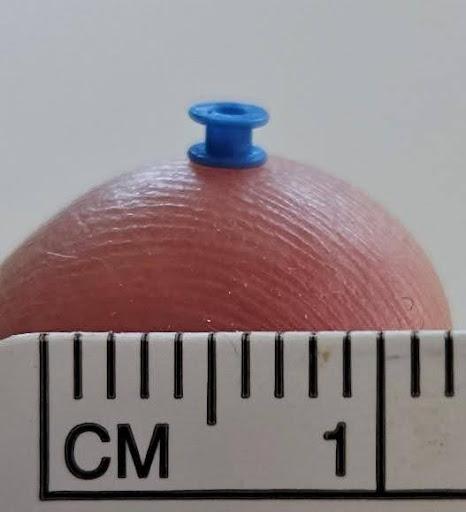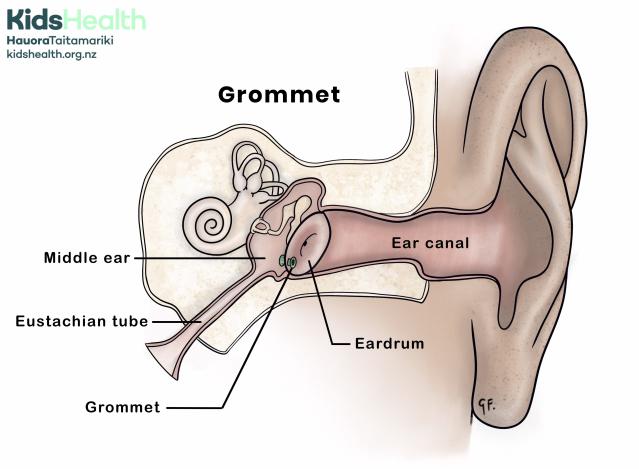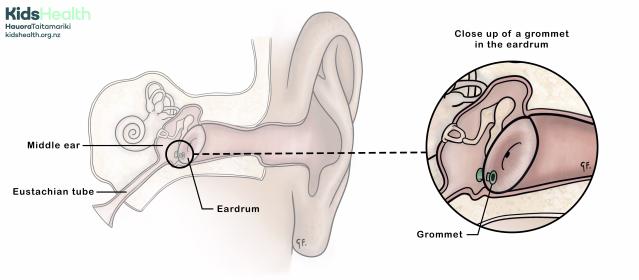Key points about grommets
- grommets are tiny plastic tubes inserted into your child's eardrum in a short operation
- a health professional may recommend grommets if your child has frequent ear infections or glue ear (middle ear fluid that hasn’t cleared away)
- grommets allow air into the middle ear (the space behind the eardrum), which allows the eardrum to move freely, improving hearing
You might find it helpful to check the information on ear infections and glue ear first.
What are grommets?
Grommets are also called tympanostomy or ventilation tubes. They are tiny plastic tubes which are inserted into a small slit in your child's eardrum in a short operation.

Close-up photo of a grommet.
How grommets work
Grommets are a temporary measure to help while your child's eustachian tubes are not working well. The eustachian tubes connect the middle ear (the space behind the eardrum) of each ear to the back of the nose. They should open briefly and often to allow the air pressure to equalise in the middle ear. In some young tamariki (children), the eustachian tubes don’t work well, making them more likely to get ear infections or glue ear. As tamariki get older and their bodies grow and mature, their eustachian tubes usually function better.

An illustration showing a grommet placed in the eardrum to help air flow into the middle ear and prevent fluid build-up.
Source: KidsHealth
transcribeTranscript
The illustration shows a cross-section of the outer, middle, and inner ear.
- The ear canal, eardrum, middle ear and Eustachian tube are labelled.
- A small grommet (tube) is shown sitting within the eardrum, connecting the ear canal and middle ear.
- The grommet allows air to pass through, helping prevent fluid build-up.
At the top left is the KidsHealth logo with the website: kidshealth.org.nz.
Grommets allow air into the middle ear from the outside. This helps to keep normal middle ear pressure and reduces the risk of fluid building up in that space. Most grommets stay in place for about 9 to 18 months and usually come out by themselves.

An illustration showing a grommet in the eardrum, allowing air to pass between the ear canal and middle ear. The close-up shows the grommet’s position in the eardrum.
Source: KidsHealth
transcribeTranscript
The illustration shows a cross-section of the outer, middle, and inner ear.
- The ear canal, eardrum, middle ear, and Eustachian tube are labelled.
- A grommet is shown within the eardrum, connecting the ear canal to the middle ear.
- A dashed line leads to a magnified close-up on the right side, showing the grommet fitted through the eardrum.
At the top left is the KidsHealth logo with the website: kidshealth.org.nz.
Why some children need grommets
A health professional may recommend grommets if your child has frequent ear infections or glue ear. They are more likely to recommend grommets if your child has had:
- glue ear for more than 3 months in both ears
- glue ear with hearing difficulties and/or concerns about speech development
- 6 acute ear infections in one year
- repeat ear infections through the summer months
- previous complications because of ear infections, such as a burst eardrum
How grommets can help
With grommets in place, any hearing loss caused by fluid in the middle ear will usually improve straight away.
Parents often report a better quality of life for their tamariki after grommet insertion with better sleeping, learning at school and overall behaviour.
How grommets are put in
Your child will need to have a short general anaesthetic to have their grommets put in. They will only need to spend a few hours at the hospital and won't need to stay the night.
- your child will need a brief general anaesthetic, meaning they are completely asleep for the procedure
- the surgeon makes a small cut in the eardrum and puts the grommet in
- the surgery usually takes about 10 to 15 minutes
- a specialist ENT (ear, nose and throat) surgeon or registrar will do the operation
What to expect after grommet insertion
After the operation
When your child has recovered and is wide awake, they are usually allowed to go home. This is often an hour or so after the operation. Your child may be a little unsettled when they first wake up after the anaesthetic, but they are usually back to normal after a few hours. They can usually return to preschool or school the following day.
Improved hearing
Many parents notice an immediate improvement in their child's hearing. Their child may comment on hearing things they haven’t been able to hear before. If there have been concerns about speech, it can take a while for these things to improve, as tamariki need to make sense of the things they are hearing.
Leaking fluid
Some tamariki may have leaking of fluid from their ears at some stage after grommets have been inserted. This is not usually painful. It is important that they see a heath professional if this happens, as it is always recommended to be treated with ear drops. This treats the infection directly and also helps stop the grommet from blocking.
Infection or leaking from the ear can happen in some tamariki after water goes into the ear after swimming or washing. If your child's ear discharge continues, they may need ear plugs to stop water going into their ears and your health professional may send your child to an ear nurse specialist or ENT specialist for further treatment.
After-care with grommets
Water going into the ears
After your child’s grommet insertion, talk to your child’s surgeon about ear protection when you child is in water (swimming, shampooing, showering and bathing). Some tamariki can get ear infections and discharge after being in water. Your child’s health professional will give you advice on what to do.
What if fluid is coming out of my child's ears?
If your child gets an ear infection, pus can flow out through the grommet and you may see it at the outer entrance to the ear canal.
See a health professional or ear nurse if your child has any fluid leaking from their ears. The health professional may take a swab. This will show any bacteria that may be causing the discharge.
The health professional may prescribe some ear drops for your child. Ear drops are more effective than antibiotics by mouth in treating discharging ears. Sometimes, your child might also get help at your local ear clinic from an ear nurse specialist.
Possible complications of grommets
Blocked grommet
A grommet may occasionally block. If this happens, your child may need ear drops to help clear it.
Ongoing leaking fluid
A small number of tamariki may keep getting fluid leaking from their ears. This needs to be treated with ear drops. Some tamariki may need earplugs to stop water going into their ears during swimming, bathing and hairwashing.
Hole in the eardrum
There is a small risk of a hole remaining in the eardrum after the grommet comes out. If this happens, you may need to take extra care to prevent water going into the ear. If the hole doesn’t heal on its own, an operation to repair the hole may be necessary when your child is over 8 years old.
The grommet may not come out on its own
In a small number of tamariki, grommets may not come out by themselves within 3 years. If this happens, your child may need a further brief general anaesthetic to remove the grommets. This would usually only be done if your child is not still at risk of having ear infections or “glue ear. You can discuss this with your health professional or ENT specialist.
Needing more than one set of grommets
Some tamariki continue to have ear problems (glue ear or repeated ear infections) once the grommets come out. They may need more grommets inserted.
If your child needs a further set of grommets, sometimes your ENT surgeon may also recommend removal of your child's adenoids. There is some evidence that removing the adenoids is helpful in those tamariki who need more than one set of grommets. The adenoids are located at the back of the nose and can contribute to the eustachian tube not working well.
Acknowledgements
Illustrations by Dr Greta File. Property of KidsHealth.
Photo of grommet courtesy of Dr Nikki Mills.
